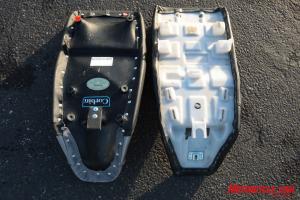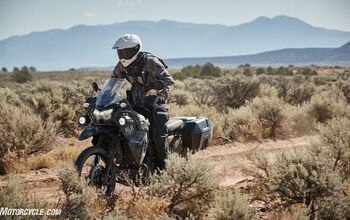Kawasaki KLR650 Project Bike: Part 9
Your five senses know what they like. When they don’t, they tell you in one way or another, sometimes with less grace than you prefer.
Burn-outs are fun for the heart, but stinky. GP bikes sound fun, too, but they can pierce eardrums. So taking precautions is a necessary step just to get through life without expiring too early. Doing it in comfort is the next logical step, if not down right American.
The cushy life is the better one, right? So when making those decisive calls for your motorcycle, choosing a saddle for example, you want something that works for both your body and your wallet. Finding the right saddle for your bike is a calculated dance between a rider’s weight, and the saddle’s style, shape and construct.
Who Is Corbin?
Corbin has been making saddles, saddlebags and fairings for more than 40 years, an American icon in the motorcycling community with good old American craftsmanship. Corbin’s Hollister, California, factory is open for ride-in purchasing, support and factory tours if you’re so inclined to learn more about construction as well as Corbin’s race support history.
If you’re not a Nor-Cal local, Corbin offers products for sale online with a quick and easy way to find what you need. Shop by make and model, click and ship.
In our case, Corbin makes three models for the Kawasaki KLR. All three models fit all model years of the KLR thanks to the simplicity of the machine itself. The choices include a Low, a Flat and a Dished model, and we opted for the most standard-like dual-sport Flat model. The dished model is more road-rider oriented and 1.5-inches lower than stock. The Low is presumably lower than that, but their website doesn’t say by how much. All three models retail for $379.
Materials
We considered going wild with our test saddle, but the baby alligator carbon fiber and rattlesnake side panels were all out of stock – must have been the Christmas rush! So we settled on Corbin’s (website) suggested construction of carbon fiber for the seating, and asphalt for the side panels. Welting is a personal choice and an option we avoided.
The carbon-fiber material Corbin refers to is actually textured leather with a nylon weave bonded to the surface for seating traction and styling looks. Breathing and breaking in like a traditional leather saddle takes some care and conditioning, so be sure to check out the available products when purchasing your saddle.
The gripper-like ‘asphalt’ side panels are a rough textured vinyl available only in black and best for those riders manipulating their bikes with their thighs, such as when trail riding while standing.
One note about coloration: While there’s a rainbow of materials and colors to choose from, all meant to match your paint and imagination, there might be some difference between what you see online and what you get in person. If you get a chance, find Corbin on tour at a rally this summer or visit a showroom to be sure you pick out exactly what you want. While I thought the “Charcoal” vinyl carbon-fiber color chip looked like an 80% grey online, it’s actually more “silver” in person, and luckily, much cooler as it now matches the stock paint scheme of the KLR. Be sure to click on the chip for a larger peek, it’s closer to true.
Installation
Though the Corbin Flat saddle feels heavy coming out of the box, it’s a mere 3 pounds heavier than the 6-pound Kawasaki accessory gel saddle. Installation is pretty simple, with parts to spare!
Remove the side panels once again with your handy 6mm socket wrench. Two more 8mm bolts hold the saddle to the frame. Where the original base plate – used to construct the aftermarket gel saddle – is plastic, the Corbin base is made of the company’s exclusive rigid Fibertech (for proper ergonomic support) with vibe-reducing rubber bumper guards where the stock saddle touched the frame with only plastic. Along with the beefier leather-wrapped under-seat frame tongue - meant to hold down the leading end of the saddle – vibrations are kept to a minimum.
One place I experienced minor difficultly with the installation was getting the side mounting holes to line up the first time. Due to the now-thicker tongue, getting the saddle to creep forward enough to line up the frame-threaded bolt holes took leveraging the tail end of the saddle with a wrench (don’t take my lead here!) and leaning down on the saddle from the top to get it right. Then toss out the washers from the stock saddle, as the new holes aren’t the same size nor do you need them for the new metal-to-metal contact point.
Following the instructions would have been a good idea from the start, as I failed to reroute the fuel overflow lines. Oops. The directions didn’t ship in the box, so click on the PDF found in the notes section for each saddle on Corbin’s website.
Mounted and ready to ride, you’ll first notice the Corbin flat looks, well, flat – not very plush looking. But that’s not exactly what you want on treks like most KLR owners ride. The Flat will leave you with an overall lower saddle height from the stock position. With the gel seat coming off our bike, there is no difference in seat height after all, both at 34.5-inches.
In Action
Tools now put away, you can entertain the more excitable sensations with a ride on your new Corbin saddle. Our first ride felt higher and our sightlines above the road increased, as did our reach to the ground despite the equal saddle height form the ground.
The extra reach is due in part to the stiffness of the patent-protected Contoured comfort cell, as well as the width of the saddle at its lowest point. Compared to the Gel saddle, the ground height is the same, but the low-slung point in the arc of the saddle is 2-3 inches toward the rear of the bike and wider by nearly 3 inches. Where the gel saddle’s cross-section is arced, the Corbin Flat is, well, flat. More like the bottom of a bread loaf versus the curved top.
That wideness is part of Corbin’s success. Pressure points are no longer on the ischium bone of the rider’s pelvis and instead the fatty cheeks and thighs of the rider. This offers more square inches of contact for more even weight distribution and a more comfortable ride.
In The Long Run
I’ll have to keep y’all posted, but I have good feelings, literally, about the Corbin Flat saddle. Once the rains stop here in Los Angeles, I’ll be able to ride with comfort to not only my bottom, but also my dry clothing. Call me a wimp. I can take it.
Related Reading
Kawasaki KLR650 Project Bike: Part 1
Kawasaki KLR650 Project Bike: Part 2
Kawasaki KLR650 Project Bike: Part 3
Kawasaki KLR650 Project Bike: Part 4
Kawasaki KLR650 Project Bike: Part 5
Kawasaki KLR650 Project Bike: Part 6
Kawasaki KLR650 Project Bike: Part 7
Kawasaki KLR650 Project Bike: Part 8
More by Alfonse Palaima
































Comments
Join the conversation